


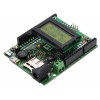







156,51 zł Netto
Programowalna płytka o rozmiarze Arduino, oparta na mikrokontrolerze Atmel ATmega32U4 z rodziny AVR. Wersja z wlutowanymi złączami, z gniazdem kart micro-SD, z wyświetlaczem LCD. Pololu 3115

darmowa wysyłka na terenie Polski dla wszystkich zamówień powyżej 500 PLN

Jeśli Twoja wpłata zostanie zaksięgowana na naszym koncie do godz. 11:00

Każdy konsument może zwrócić zakupiony towar w ciągu 14 dni bez zbędnych pytań
DESCRIPTION
Overview
The A-Star 32U4 Prime SV is a programmable board based on Atmel’s ATmega32U4 microcontroller and arranged in the common Arduino form factor. The A-Star Prime offers many additional features and improvements over competing products, including superior power management that enables efficient operation from 5 V to 36 V. The A-Star 32U4 Prime SV is available in several configurations; item #3115 includes preinstalled female headers common to many Arduinos, microSD support, and a removable 8×2 character LCD.
The Pololu A-Star 32U4 Prime is a general-purpose programmable board based on Atmel’s ATmega32U4 AVR microcontroller and arranged in the common Arduino form factor exemplified by the Uno R3 and Leonardo. As such, the A-Star Prime (abbreviated A* Prime) is compatible with many Arduino shields, including all of the Arduino shields we carry. All 26 of the microcontroller’s GPIO lines are accessible on the board, including seven than can be used as PWM outputs and twelve that can be used as analog inputs. The ATmega32U4 is capable of native full-speed USB, which makes it more versatile than similar boards that rely on USB-to-serial adapters: in addition to supporting a virtual (CDC) serial/COM port interface, the A-Star can appear to a connected computer as a mouse and keyboard. The A-Star’s USB interface can be accessed through its USB Micro-B connector.
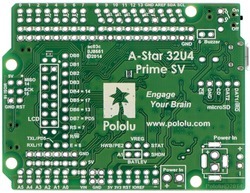
A-Star 32U4 Prime SV, bottom view.
The A* Prime supports the on-board microcontroller with many additional features and improvements over competing products, including enhanced connectivity and superior power management. The Prime is available in two main versions: SV, which features a green solder mask and a switching step-down regulator that allows operation from 5 V to 36 V, and LV, which features a blue solder mask and a step-up/step-down voltage regulator that allows operation from 2.7 V to 11.8 V. Each version is available in several different configurations: with or without preinstalled through-hole components like standard Arduino female headers and with or without microSD support. There is also a configuration available for each version with an 8×2 character LCD.
A-Star 32U4 Prime SV (5 V to 36 V) configurations:
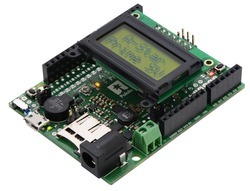
A-Star 32U4 Prime SV microSD with LCD.
A-Star 32U4 Prime LV (2.7 V to 11.8 V) configurations:
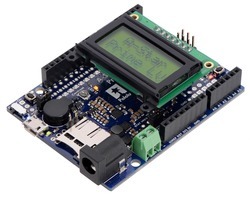
A-Star 32U4 Prime LV microSD with LCD.
We carry an A-Star Prime accessory pack that contains an assortment of parts you might want when assembling the configurations without preinstalled headers (items #3105, #3106, #3111, and #3112).
Our comprehensive user’s guide provides the basics you need to get started with the A-Star as well as detailed technical information for advanced users.
Features
Details for item #3115
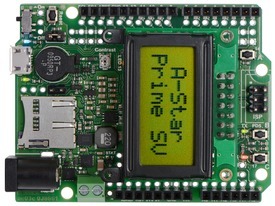
A-Star 32U4 Prime SV microSD with LCD.
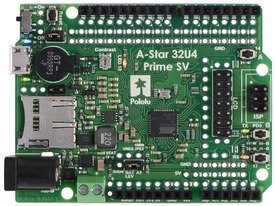
A-Star 32U4 Prime SV microSD with LCD (shown with LCD removed).
This configuration of the A-Star 32U4 Prime SV includes microSD support and is assembled with through-hole components as shown in the picture above so that all the basic features can be used without any additional soldering. The standard female headers common to many Arduinos are preinstalled, as is the 2×3 male ISP header, 2×7 male LCD connector, buzzer, DC power jack, and shorting block headers for enabling the microSD hardware, buzzer, and battery voltage monitor. A removable 8×2 character LCD is included with this configuration, and a preinstalled 2-pin terminal block provides an alternate way of supplying input power to the board. This is the SV version of the A-Star Prime, which operates from 5 V to 36 V.
A-Star 32U4 Prime SV 5 V regulator
A major feature of the A* Prime SV is its power system, which allows it to efficiently operate from a 5 V to 36 V external source. The input voltage is regulated to 5 V by an ISL85410 switching step-down (buck) converter from Intersil, a higher-power version of the ISL85415 used on the smaller A-Star 32U4 Mini SV. (We also make a standalone regulator based on this integrated circuit.)
As shown in the left graph below, the SV’s 5 V switching regulator has an efficiency – defined as (Power out)/(Power in) – of 80% to 95% for most combinations of input voltage and load.
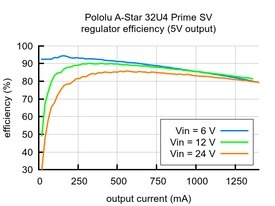
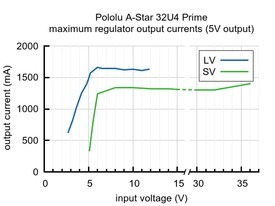
The A-Star’s components, including the microcontroller and LEDs, draw 30 mA to 40 mA in typical applications (without the buzzer, microSD card, or an LCD). The rest of the regulator’s achievable output current, which depends on input voltage as well as ambient conditions, can be used to power other devices. The green line in the right graph above shows the output currents where the regulator’s output voltage drops below 4.75 V. These currents are close to the limits of the regulator’s capability and generally cannot be sustained for long periods; under typical operating conditions, a safe limit for the maximum continuous regulator output current is approximately 1 A.
The dropout voltage of a step-down regulator is defined as the minimum amount by which the input voltage much exceed the regulator’s target output voltage in order to assure the target output can be achieved. As can be seen in the graph below, the dropout voltage of the Prime SV’s regulator increases approximately linearly with the output current. For light loads where the dropout voltage is small, the board can operate down to 5 V. However, for larger loads, the dropout voltage should be taken into consideration when selecting a power supply; operating above 6 V will ensure the full output current is available.

Arduino compatibility
The A-Star 32U4 Prime ships with a preloaded Arduino-compatible bootloader (which uses 4 KB of flash memory, leaving 28 KB available for the user program). We provide a software add-on that enables the board to be easily programmed from the Arduino environment and an Arduino library to make it easy to use the additional on-board hardware. The A-Star 32U4 has the same microcontroller and form factor as the Arduino Leonardo, and it runs at the same frequency, so we generally expect it to work with shields that are compatible with the Leonardo and similar boards. Note that the Prime has additional components and connection points, so you should make sure these do not physically interfere with any shield you are considering using. The following table shows how the Prime compares to the Leonardo and Uno:
 Arduino Uno R3 |  Arduino Leonardo |  A-Star 32U4 Prime LV |  A-Star 32U4 Prime SV | ||
|---|---|---|---|---|---|
| Microcontroller: | ATmega328P | ATmega32U4 | ATmega32U4 | ||
| Clock: | 16 MHz resonator | 16 MHz crystal | 16 MHz crystal | ||
| User I/O lines: | 20 | 23 | 26 | ||
| PWM outputs: | 6 | 7 | 7 | ||
| Analog inputs: | 6 | 12 | 12 | ||
| Ground access points: | 4 | 4 | 43 | ||
| User LEDs: | 3 | 3 | 3 | ||
| User pushbuttons: | — | — | 3 | ||
| Reset button: | YES | YES | YES | ||
| Power switch: | YES | ||||
| Buzzer option: | YES | ||||
| microSD option: | YES | ||||
| LCD option: | YES | ||||
| Arduino-compatible bootloader: |
YES | YES | YES | ||
| USB connector: | B | Micro-B | Micro-B | ||
| USB/regulator power selection: |
partial | partial | TPS2113A | ||
| High-performance reverse-voltage protection: |
YES | ||||
| Recommended input voltage: |
7 V to 12 V | 7 V to 12 V | 2.7 V to 11.8 V | 5 V to 36 V | |
| Regulator type (5 V): | linear | linear | switching step-up/step-down |
switching step-down |
|
| Available 5 V output current: |
at 3 V in | — | — | 0.75 A | — |
| at 5 V in | — | — | 1.5 A | 0.2 A | |
| at 7 V in | 1.0 A | 1.0 A | 1.5 A | 1.0 A | |
| at 9 V in | 0.5 A | 0.5 A | 1.5 A | 1.0 A | |
| at 11 V in | 0.35 A | 0.35 A | 1.5 A | 1.0 A | |
| at 24 V in | — | — | — | 1.0 A | |
| via USB connector |
0.5 A(1) | 0.5 A(1) | 1.5 A(1) | 1.5 A(1) | |
| Weight: | 28 g | 20 g | 13 g to 33 g | ||
1 With sufficiently capable USB power supply.
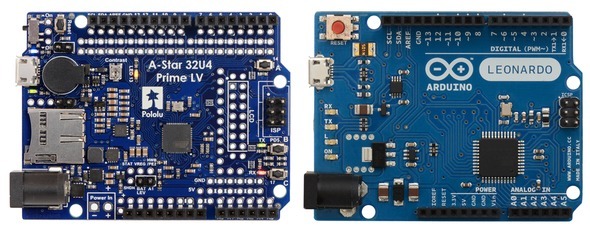
Side-by-side comparison of the A-Star 32U4 Prime LV microSD to the Arduino Leonardo.
SPECIFICATIONS
Dimensions
| Size: | 2.8″ × 2.1″ (common Arduino form factor) |
|---|---|
| Weight: | 33 g |
General specifications
| Processor: | ATmega32U4 @ 16 MHz |
|---|---|
| RAM size: | 2560 bytes |
| Program memory size: | 32 Kbytes1 |
| Motor channels: | 0 |
| User I/O lines: | 26 |
| Input voltage range: | 5 V to 36 V (SV) |
| Minimum operating voltage: | 5 V2 |
| Maximum operating voltage: | 36 V |
| Maximum output current: | 1.0 A3 |
| Logic voltage: | 5 V |
| Reverse voltage protection?: | Y |
| External programmer required?: | N |
Notes:
RESOURCES
Documentation and other information
File downloads
Recommended links
Cechy
A-Star 32U4 Prime LV microSD to płytka bazowa oparta o mikrokontroler ATmega32U4. A-Star Prime oferuje wiele nowych funkcjonalności w tym możliwość zasilania napięciem w zakresie 5-36V. Pololu 3114
Brak towaru
Płytka uruchomieniowa zgodna z Arduino z mikrokontrolerem Atmega32U4 i przetwornicą step-up/step-down. Wersja bez przylutowanych elementów przewlekanych. Pololu 4005
A-Star 32U4 Mini ULV to płytka bazowa oparta o mikrokontroler ATmega32U4. Płytka może być zasilana napięciem od 0,5 V do 5,5 V, posiada 26 wyprowadzonych pinów GPIO (w tym 7 PWM i 12 ADC). Pololu 3102
Brak towaru
A-Star 328P Micro to niewielka płytka bazująca na mikrokontrolerze ATmega 328PB. Układ posiada wgrany bootloader zgodny z Arduino. Płytka ma 24 porty I/O (z czego 9 pinów może pełnić funkcje wyjść PWM a 8 pinów wejść analogowych). Płytka pracuje z napięciem logicznym 3.3 V. Pololu 3162
Platforma oparta o mikrokontroler ATmega32U4 z portem microUSB i 18 cyfrowymi portami I/O z czego 7 wspiera modulację PWM, a 8 może pracować w trybie analogowym. Pololu 3101
Brak towaru
Płytka uruchomieniowa zgodna z Arduino Leonardo wyposażona w mikrokontroler Atmega32U4, czytnik kart SD, wyświetlacz tekstowy 8x2 znaki i przetwornicę step-up/step-down. Pololu 4009
A-Star 32U4 Prime LV to płytka bazowa oparta o mikrokontroler ATmega32U4. Płytka jest zgodna wymiarami i złączami z popularną płytką Arduino. A-Star Prime oferuje wiele nowych funkcjonalności w tym możliwość zasilania napięciem w zakresie 2,7-11,8 V. Pololu 3107
Płytka uruchomieniowa zgodna z Arduino Leonardo wyposażona w mikrokontroler Atmega32U4 i przetwornicę step-up/step-down. Pololu 4007
A-Star 328P Micro to niewielka płytka bazująca na mikrokontrolerze ATmega 328PB. Płytka ma 24 porty I/O (z czego 9 pinów może pełnić funkcje wyjść PWM a 8 pinów wejść analogowych). Płytka pracuje z napięciem logicznym 5 V. Pololu 3161
A-Star 328P Micro to niewielka płytka bazująca na mikrokontrolerze ATmega 328PB. Układ posiada wgrany bootloader zgodny z Arduino. Płytka ma 24 porty I/O (z czego 9 pinów może pełnić funkcje wyjść PWM a 8 pinów wejść analogowych). Płytka pracuje z napięciem logicznym 3.3 V. Pololu 3163
Płytka uruchomieniowa zgodna z Arduino Leonardo wyposażona w mikrokontroler Atmega32U4, czytnik kart SD i przetwornicę step-up/step-down. Wersja bez przylutowanych elementów przewlekanych. Pololu 4006
A-Star 328P Micro to niewielka płytka bazująca na mikrokontrolerze ATmega 328PB Układ posiada wgrany bootloader zgodny z Arduino. Płytka ma 24 porty I/O (z czego 9 pinów może pełnić funkcje wyjść PWM a 8 pinów wejść analogowych). Płytka pracuje z napięciem logicznym 5 V. Pololu 3160
Platforma oparta na mikrokontrolerze Atmega 32U4 z domyślnie wgranym bootloaderem zgodnym z Arduino, 26 portami O/I i portem microUSB. Pololu 3145
Płytka uruchomieniowa zgodna z Arduino Leonardo wyposażona w mikrokontroler Atmega32U4, czytnik kart SD i przetwornicę step-up/step-down. Pololu 4008
Platforma oparta o mikrokontroler Atmega 32U4 z domyślnie wgranym bootloaderem zgodnym z Arduino, 26 portami O/I i portem microUSB. Pololu 3103
Brak towaru
A-Star 32U4 Prime SV - programowalna płytka o rozmiarze Arduino, oparta na mikrokontrolerze Atmel ATmega32U4 z rodziny AVR. Wersja z wlutowanymi złączami, bez gniazda kart micro-SD, bez wyświetlacza. Pololu 3113
Brak towaru

Programowalna płytka o rozmiarze Arduino, oparta na mikrokontrolerze Atmel ATmega32U4 z rodziny AVR. Wersja z wlutowanymi złączami, z gniazdem kart micro-SD, z wyświetlaczem LCD. Pololu 3115
